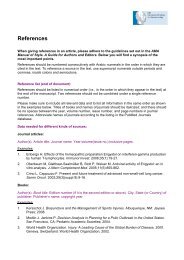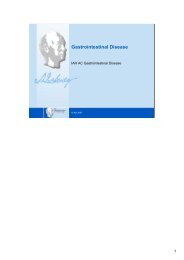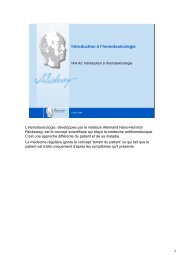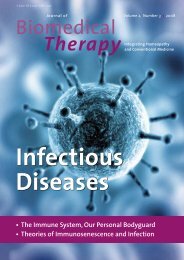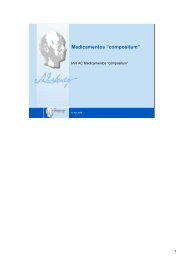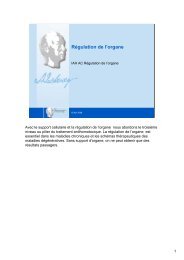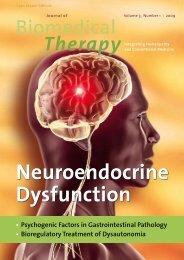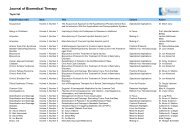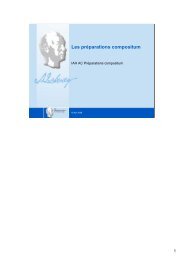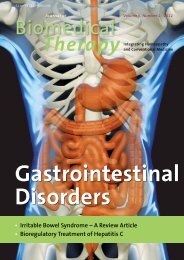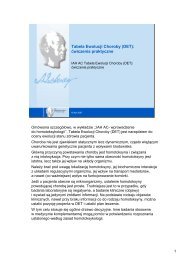Metabolic Syndrome - International Academy of Homotoxicology
Metabolic Syndrome - International Academy of Homotoxicology
Metabolic Syndrome - International Academy of Homotoxicology
You also want an ePaper? Increase the reach of your titles
YUMPU automatically turns print PDFs into web optimized ePapers that Google loves.
) Research Highlights<br />
Emotional Stabilization<br />
Through Homeopathic Medication<br />
Neurexan reduces the psychological strain <strong>of</strong> stress<br />
In a randomized, placebo-controlled<br />
double-blind study, neurophysiological<br />
methods were used to<br />
determine the effects <strong>of</strong> Neurexan<br />
on patients’ psychophysiological<br />
con dition. The administration <strong>of</strong><br />
Neurexan was found to help them<br />
to cope better with acute stress situations.<br />
The homeopathic combination medication<br />
Neurexan consists <strong>of</strong> the<br />
components passionflower (Passiflora<br />
incarnata), oats (Avena sativa),<br />
caffeine (C<strong>of</strong>fea arabica), and zinc<br />
salts (Zincum isovalerianicum) in<br />
homeopathic dosages. The literature<br />
contains a number <strong>of</strong> references<br />
to the tension-relieving, anxiolytic<br />
properties <strong>of</strong> the passionflower.<br />
Exposure to a stressful situation<br />
To investigate the effect <strong>of</strong> Neurexan<br />
during mental strain, a total <strong>of</strong> 30<br />
persons took part in a study in which<br />
a stress situation was created. To assess<br />
their clinical condition, initial<br />
and final examinations were performed<br />
in which, in addition to a<br />
standardized clinical case history<br />
and a physical examination, an ECG<br />
was recorded, blood and urine samples<br />
were taken, and an alcohol test<br />
was performed.<br />
The healthy male and female volunteers,<br />
who were between 30 and 60<br />
years <strong>of</strong> age, underwent a test in<br />
which they had to solve mathematical<br />
problems. If they solved the<br />
problems well, volunteers received a<br />
reward (increase in volunteer remuneration);<br />
if they did badly, they received<br />
a “punishment” (loss <strong>of</strong> remuneration).<br />
During the study, either<br />
active medication or a placebo was<br />
used in a single dose <strong>of</strong> 4 tablets in<br />
each case. EEGs <strong>of</strong> the study participants<br />
were recorded. The recordings<br />
were repeated hourly until four<br />
hours after the administration <strong>of</strong> the<br />
tablets.<br />
It is assumed that different emotional<br />
moods are shown by statistically<br />
significant changes in the electrical<br />
activity <strong>of</strong> the brain. Six frequency<br />
ranges (delta, theta, alpha, alpha 2,<br />
beta 1, and beta 2) were therefore<br />
defined for the analysis <strong>of</strong> the quantitative<br />
EEG and color-coded.<br />
Sharp rises in the beta waves are observed<br />
mainly during cognitive tasks<br />
and powerful emotional events such<br />
as the mentally stressful situations<br />
that were part <strong>of</strong> the study design.<br />
During the study there was a clear<br />
reduction in spectral output in the<br />
beta frequency band in the Neurexan<br />
group. After just one hour, a significant<br />
difference was seen between<br />
the Neurexan group and the placebo<br />
group, which intensified in the second<br />
and third hours. The reduced<br />
rise in the beta waves is a sign <strong>of</strong> the<br />
lesser subjective strain in the active<br />
medication group and is evidence <strong>of</strong><br />
emotional stabilization.<br />
The test substances were very well<br />
tolerated. In a few cases the volunteers<br />
complained <strong>of</strong> tiredness.<br />
Conclusion<br />
The single dose <strong>of</strong> 4 tablets <strong>of</strong> Neurexan<br />
produces statistically significant<br />
changes in electrical brain activity<br />
compared to placebo. This is<br />
interpreted as evidence <strong>of</strong> a more<br />
balanced mood, which makes it<br />
possible to cope better with psychological<br />
strain in stressful situations<br />
without mental functions being<br />
impaired. |<br />
) 26<br />
The passionflower (Passiflora incarnata)<br />
has anxiolytic properties and is<br />
used for the treatment <strong>of</strong> nervousness<br />
and insomnia.<br />
Reference:<br />
Dimpfel W. Psychophysiological effects <strong>of</strong> Neurexan<br />
® on stress-induced electropsychograms. A<br />
double-blind, randomized, placebo-controlled<br />
study in human volunteers. Paper presented at:<br />
2nd World Conference <strong>of</strong> Stress; August 23-26,<br />
2007; Budapest, Hungary.<br />
Journal <strong>of</strong> Biomedical Therapy 2008 ) Vol. 2, No. 1



